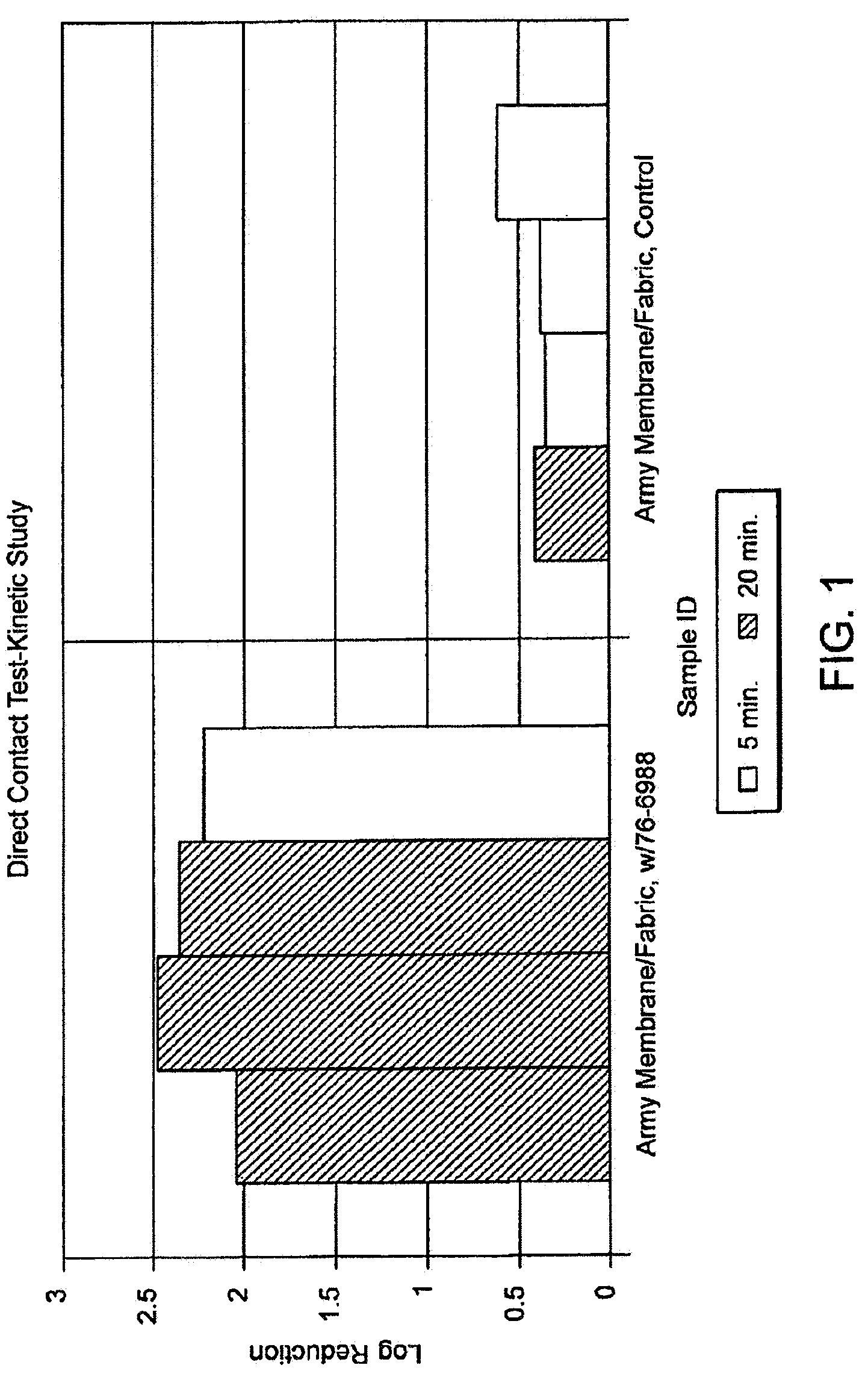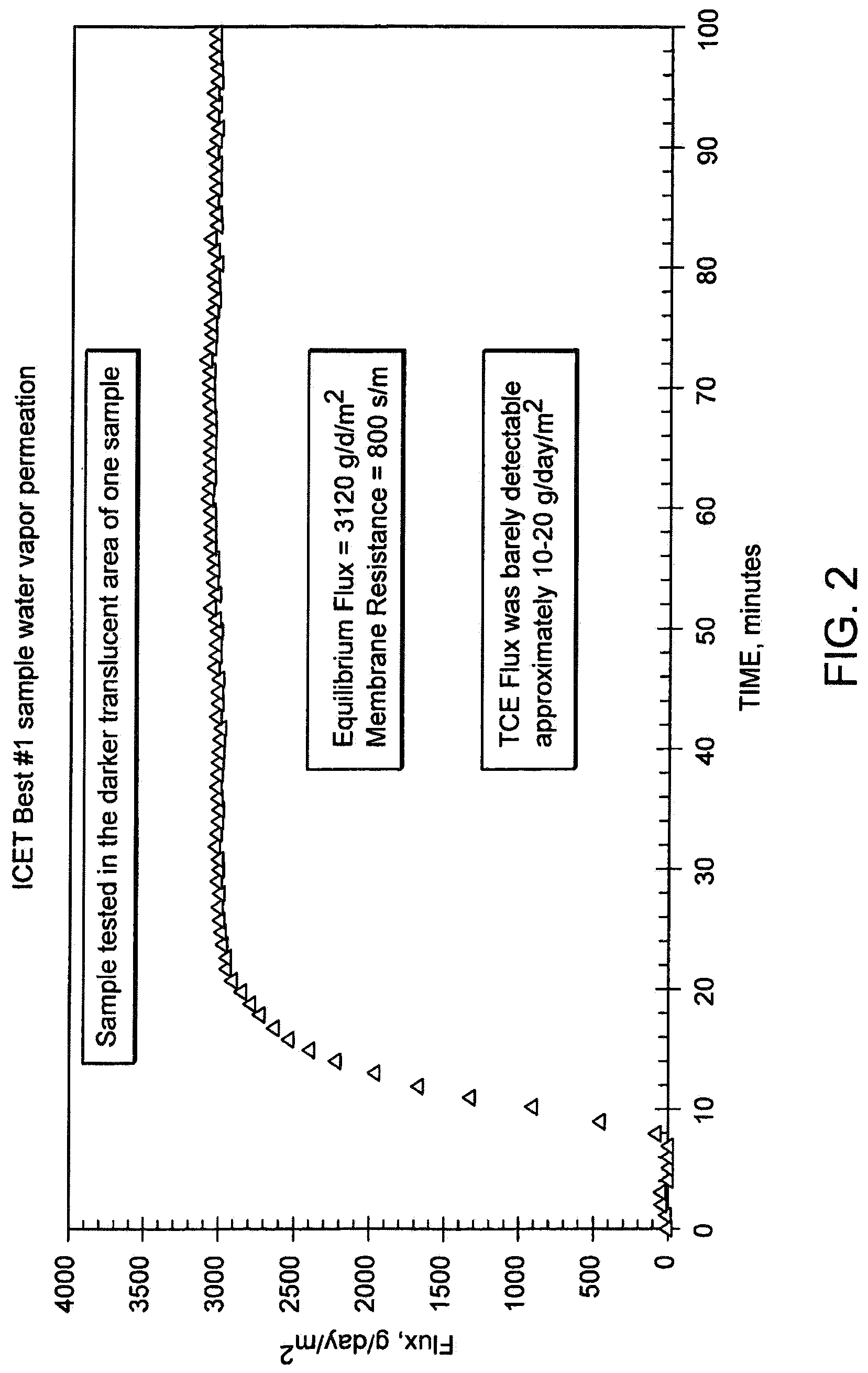Material compositions for microbial and chemical protection
a technology of chemical protection and material composition, applied in the field of chemical formulations, can solve the problems of cbw problem more difficult, carbon tends to retain toxic ingredients or organisms, and the surrounding is contaminated and other problems, to achieve the effect of preventing cbw from spreading
- Summary
- Abstract
- Description
- Claims
- Application Information
AI Technical Summary
Benefits of technology
Problems solved by technology
Method used
Image
Examples
example i
[0053]This example illustrates the excellent barrier effects of very thin coatings of cross-linked polyvinylalcohol and fluorocarbon to ward actual chemical warfare agents. (Experiments carried out by Geomet Technologies, Gaithersburg, Md.). The notations “leak” and “adjacent cell” found in the table refers to leaks occurring through the rubber washer of the diffusion cell. According to Geomet, the leak is apparently caused by the poor sealing between the sample and washer in some cases and due to the attack of the sealing by the diesel in those tests where fuel resistance was tested. It required that such coatings maintain the barrier properties even after exposure to diesel. Also the leak affected the adjacent cell's color test paper as revealed from the color pattern developed. According to Geomet, these samples would have taken longer time to reach end points, if the leak had not occurred.
[0054]The cross-linked PVA coatings even after 10-minute exposure to diesel gave improvemen...
example 2
[0059]This example describes the preparation of a hydrophilic polyurethane material with ethylene polyvinylalcohol component. The latter adds barrier properties to organics while the polyurethane component allows moisture vapor transmission.
Dissolution of Ethylene Vinyl Copolymer LC-E151A
[0060]This copolymer has a glass transition temperature of 49° C. Solubility of this copolymer in organic solvents will be more rapid above this temperature. Of these solvents, it was decided to use DMSO for the initial work. A solution of the LC-E151A was made up in DMSO as follows:
[0061]
LC-E151A10.0 grams pelletsDMSO (Spec Grade)50.0 mL
[0062]The LC_E151A-DMSO was stirred in a closed container, with a thermocouple in the liquid phase, in a mineral oil bath. The temperature was raised slowly to 94-95° C. Complete dissolution required approximately 2.5 hours. Two separate master batches were made. In order to reduce the amount of DMSO used, 1-propanol and tetrahydrofuran were added to separate portio...
example 3
[0078]This example describes the CBW protective components of composite that consists of a membrane (not more than 5 mils in thickness) forming the underlayer for nylon or nylon / cotton or cotton or polyester or the triblend (nylon / cotton / Kevlar). The fillers from this invention are added to the PTFE resin and membranes of 1-5 mils thickness of varying porosities could be extruded.
The Concept of a “Triple Defense” CBW Protective Clothing
[0079]Our model for a composite fabric consists of a CBW deactivating shell fabric which is made of Nylon / cotton or Nylon with an under layer of microporous expanded PTFE membrane containing potent CBW deactivating agents. The PTFE is laminated with the special hydrophilic cross-linked polyvinylalcohol layer that is impermeable to CBW agents but highly permeable to water vapor. The micropores of the PTFE membrane can be tailor made ranging from 0.1 micron to 1 micron. The loading level of the fillers is of the order of 1-2%.
[0080]Microporous membranes...
PUM
| Property | Measurement | Unit |
|---|---|---|
| pressure | aaaaa | aaaaa |
| surface area | aaaaa | aaaaa |
| surface area | aaaaa | aaaaa |
Abstract
Description
Claims
Application Information
 Login to View More
Login to View More - R&D
- Intellectual Property
- Life Sciences
- Materials
- Tech Scout
- Unparalleled Data Quality
- Higher Quality Content
- 60% Fewer Hallucinations
Browse by: Latest US Patents, China's latest patents, Technical Efficacy Thesaurus, Application Domain, Technology Topic, Popular Technical Reports.
© 2025 PatSnap. All rights reserved.Legal|Privacy policy|Modern Slavery Act Transparency Statement|Sitemap|About US| Contact US: help@patsnap.com


